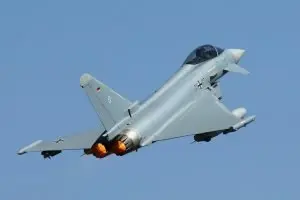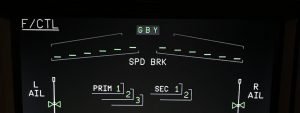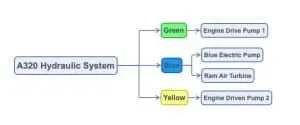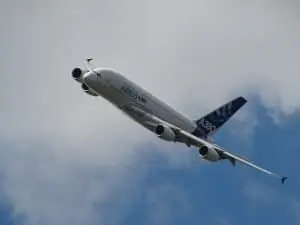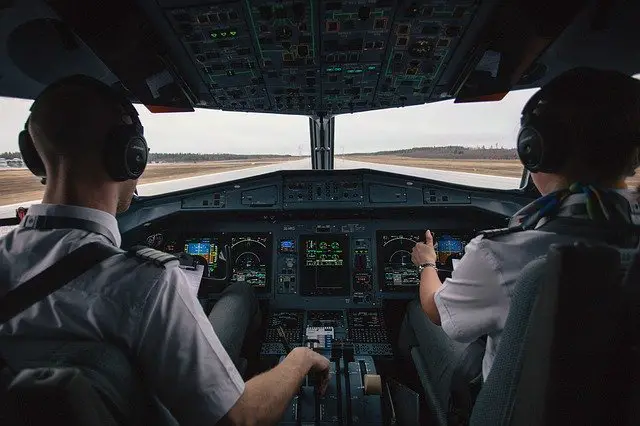
Pete has been flying aircraft for the last 20 years. He has flown everything from light piston aircraft up to heavy jets as both First Officer and Captain. He’s currently enjoying life flying the Airbus A330 for a major international airline.
Inflight turbulence affecting aircraft is caused by changing air speed and direction through which an aircraft is flying. Much like you might see eddies in a stream, these changes to the flow of the air cause atmospheric turbulence.
There are broadly four types of turbulence: Convective and Orographic Thunderstorms, Clear Air Turbulence (CAT) and aircraft Wake Turbulence.
Table of Contents

1. Convective Turbulence
Thermal instability in the atmosphere creates thunderstorm (TS) cells that first take the form of convective “cumulonimbus clouds” (CBs). Not all CB’s evolve to thunderstorms however but many of the hazards associated with thunderstorms also about to cumulonimbus cloud.
Convective thunderstorm activity occurs mostly by day, over land during the summer. As warm, moist air rises in the center of the thunderstorm cell it cools and loses its energy, creating updrafts in the center and downdrafts in the extremities.
Related: Decoding Aviation Weather Reports
Thunderstorms are less common at higher latitudes due to the inability of the colder air to hold sufficient water vapour for thunderstorms to form.
Thunderstorms are a significant hazard to aviation and can cause strong up and downdrafts, windshear, hail, airframe icing, lightening and microburst activity.

2. Orographic Turbulence
Orographic turbulence refers to turbulence generated by strong winds over terrain or obstacles caused by unstable air being lifted by the rising terrain. These orographic thunderstorms can form by day or night.
The most serious form of orographic turbulence is in the form of “Mountain Waves” where strong winds pass over mountainous terrain causing significant turbulence above the terrain and also very strong downdraughts on the lee side of the mountains. This can sometimes be evidenced by the formation of lenticular cloud above the peaks or rotor clouds on the lee side.
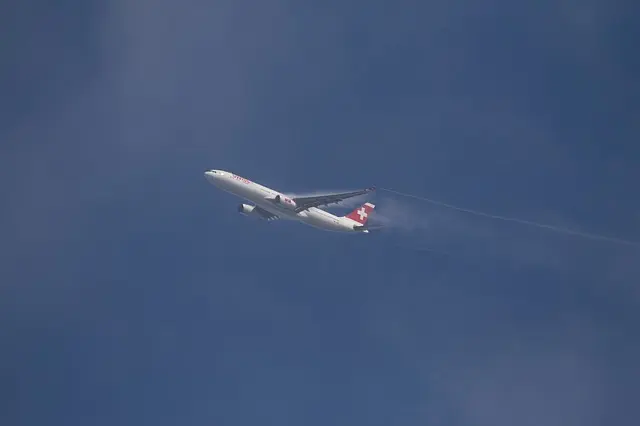
3. Clear Air Turbulence (CAT)
As the name suggests this is turbulence that can exist clear of convective cloud where thunderstorm turbulence may exist, and as such is impossible to detect on weather radar.
The most common form of CAT is encountered around the “jet stream”, a strong moving stream of air in the upper troposphere, near the tropopause, which is caused by the temperature difference between the generally warmer sub-tropical air masses and the cold polar air mass.
This difference is most pronounced during winter and this is when the highest speeds can be found. It is generally shallow (only a few thousand feet thick) but can be hundreds of miles long, with speeds frequently up to 150kts and sometimes much greater.
Apart from turbulence the other significance of turbulence on aircraft can be a large increase in ground speed (or a large reduction if flying the other way). Airlines and other aircraft operators will often take advantage of the increase in groundspeed (and subsequent reduction in flight time and fuel costs) flying eastwards by planning flights to take advantage of stronger tailwinds.
Although Clear Air Turbulence can’t be detected on aircraft weather radars it can be predicted by computer models. Additional signs available to pilots of areas of possible CAT are:
- Wind velocity change greater than 40kt over 100nm
- Temperature change greater than 4ºC over 100nm
- Areas close to polar side of jetstream
The jet stream is a narrow band of extremely strong winds (greater than 300kts) near the tropopause. Clear Air Turbulence (CAT) is likely above and below the jet stream on the polar side.

4. Aircraft Wake Turbulence
This type of turbulence is generated by aircraft as they pass through the air and is a side effect of the generation of lift by the wing. Lift is produced by an aircraft’s wing by means of a pressure differential between the lower and upper surfaces of the wing.
In a very basic explanation, the air above the wing flows at a greater speed to that below resulting in a lower pressure above and higher pressure below. This difference in pressure produces lift but where the low and high pressure air mixes (i.e. at the wingtips) wing vortices are produced.
The airflow “rolls” from below the wing around the wingtip to the top of the wing creating two counter-rotating vortices behind the aircraft.
The biggest components in determining the strength of vortices in commercial aviation are the weight and shape of the aircraft. ICAO wake turbulence category are based on weight (i.e. certified max take-off mass):
- Heavy: 136,000kg or greater.
- Medium: 7,000kg or greater, up to heavy.
- Light: 7,000kg or less.
A fourth category was added, “Super”, to accommodate the Airbus A380 which has a Max Take Off Weight of 560,000kg.
Related: Performance Factors Relating to Maximum Take Off Weight (MTOW)
The vortices descend below the aircraft and move outwards and decay when reaching the ground (at low level) or after a period of a few minutes at altitude. The tend to persist for longer durations in stable air with low wind speeds.
Aircraft are most exposed to hazardous wake turbulence when following directly behind another aircraft which is what “wake separation standards” are applied at airports both on the approach and on departure. The two techniques in use involve a time-based separation (common on departure) and distance based separation (usually on arrival).
Wake Turbulence Separation Table – Approach
| Aircraft Ahead | Aircraft Behind | Minimum Separation |
| Heavy | Medium | 5NM |
| Heavy | Light | 6NM |
| Medium | Light | 5NM |
Wake Turbulence Separation Table – Departure
| Departing Aircraft | Following Aircraft | Same Intersection | Different Intersection |
| Heavy | Medium | 2 Minutes | 3 Minutes |
| Heavy/Medium | Light | 3 Minutes | **** |
*The above examples are based on ICAO PANS-ATM Doc 4444.
Note that minimum departure separation behind the “Super” category, i.e. Airbus A380, requires an extra minute on departure and greater separation on arrival.
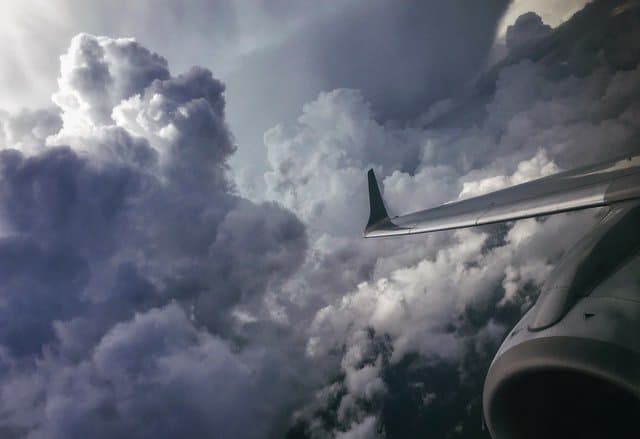
Turbulence Intensity Categories
Turbulence intensity is reported worldwide as Light, Medium and Severe. The FAA (Federal Aviation Administration) in the U.S. also has reportable categories of Light Chop, Moderate Chop and Extreme Turbulence.
Light Turbulence
Only causes slight changes in aircraft attitude or altitude. (Corresponds to accelerometer changes of 0.5g)
Inside the aircraft – passengers feel a light strain against seatbelts. Liquids are shaking but do not splash out of cups. Trolleys/carts can be manoeuvred easily.
Moderate Turbulence
Greater changes in aircraft speed and attitude but aircraft remains in control at all time. Small variations in airspeed. Difficulty in walking. Loose objects move about. Occupants feel strain against seatbelts. (Corresponds to accelerometer changes of 0.5g to 1.0g)
Inside the aircraft – passengers feel definite strain against seatbelts. Liquids splash out of cups. Trolleys/carts are difficult to manoeuvre. Difficult to stand/walk without holding on to something.
Severe Turbulence
Aircraft difficult or impossible to control for short periods, structural damage to aircraft possible, abrupt changes to aircraft attitude and/or altitude. Loose objects tossed about. Corresponds to accelerometer changes greater than 1.0g)
In the aircraft – passengers are forced violently against their seatbelts. Unsecured items are thrown about. Walking is impossible.
Turbulence Certification Requirements
Regulation stipulates a margin equivalent to 0.3g exists at max cruise altitude between low speed buffet (stall) and high speed buffet which equates to a 1.3g buffet margin.
On Airbus aircraft this is displayed as REC MAX, or Recommended Max, on the MCDU (Multi-Function Control and Display Unit). Although certification requirements specify a 1.3g margin, it is recommended to ensure a a 1.35g for conditions up to light-moderate turbulence. This greater margin is achieved by flying 1000’ below the REC MAX altitude.
Related: A Pilot’s Guide to REC MAX and OPT ALT Altitudes
For greater turbulence, consideration should be given to flying at a lower level to achieve a 1.5g buffet margin – cruising approximately 4000’ below the REC MAX level should be considered. Reference should be made to the relevant Altitude Capability Charts in the aircraft performance manual.
In order to maintain a minimum margin against buffeting and ensure good aircraft maneuverability, it is necessary to determine an acceptable load factor limit below which buffeting shall never occur. This load factor limit is generally fixed to 1.3. This value is an operating limitation, but not a regulatory one. The corresponding altitude is called the “1.3g buffet limited altitude” or “buffet ceiling”
Related: Airbus Green Dot Speed Explained
Life on the Line – Severe Turbulence over the Alps
During normal airline operations we do encounter light turbulence frequently and moderate turbulence from time to time.
As long as the proper preflight precautions are taken (avoiding areas of turbulence altogether where possible, and when avoidance is not possible, choosing the best route through it together with following the proper mitigation strategies) there is generally no issue other than suspension of service and passenger discomfort.

As for severe turbulence, encounters are more rare but they do happen.
In my career I’ve only encountered severe turbulence once. We were departing Turin, Italy on a calm, clear morning climbing out on a northerly departure.
The departures from Turin (Torino) require a circle of the airport to gain height before turning north to cross over the Alps.
It was a lovely morning for flying and all was going well until we were level with the tops of the mountains. There were very strong winds (100-150kt) at relatively low level (around FL150, 15,000’) blowing from north to south.
As soon as we were level with the tops of the terrain we went from smooth flying conditions to severe turbulence without any warning. We immediately turned on the seat belt signs, selected an appropriate speed and turned on the engine continuous ignition system. The autopilot was engaged at this stage and as it was performing well with the conditions we left it engaged and monitored it. We reported the conditions to air traffic control (ATC) to warn any other aircraft in the area.
The cabin crew were in the cabin beginning the inflight service when the turbulence began, and following their procedures, jumped into the nearest available passenger seat and strapped themselves in until we were clear. Fortunately the event only lasted a few minutes and it stopped almost as suddenly as it had started. We made contact with the cabin crew to receive a report and were relieved to hear that, although shaken, there were no injuries amongst the passengers or crew. We made a PA to explain what had happened and, as far as possible given the circumstances, to reassure the passengers. Thankfully the rest of the flight proceeded normally.
Related: Aircraft Emergency – Squawk 7700
We radioed ahead to have maintenance meet us on stand on arrival. Severe turbulence requires an entry in the aircraft’s technical log and a substantial inspection by the engineers including an engine “borescope” (where a flexible tube with a video camera on the end is used to visually inspect the engines for damage).
Additionally a general inspection of the airframe will be carried out to check for any signs of damage e.g. cracks, deformed skin, delamination, popped rivets etc.
Modern aircraft electronically record encountered flight parameters, including turbulence. This data is available to the engineers through the aircraft’s flight monitoring system. This data can then be compared against structural limits in the Aircraft Maintenance Manual (AMM) and required maintenance procedures will then be carried out.

Turbulence Avoidance/Mitigation
Preflight planning stage: Mitigation against turbulence begins first at the pre flight planning stage. Flight planners and aircraft crews will study enroute weather charts and forecasts and choose the best routing to either avoid areas of turbulence completely, or to minimise time in those areas. Preflight planning is 3D affair not just circumventing areas laterally but also considering vertical options – e.g. planning enroute altitudes to either cross above or below the forecasted area.
Related: SPECI Aviation Weather Reports Decoded
On the aircraft: Depending on the conditions and extent of the turbulence it may not be possible to avoid the area and in this case, as mentioned above, the flight will be planned through the area of least turbulence. Prior to departure the pilots will brief the cabin crew on the estimated time until turbulence may be expected and the forecast intensity.
Usually the senior cabin crew member/manager and the captain will agree a plan in relation to the service – if significant turbulence is forecast service may be delayed, curtailed or, in the case of strong turbulence for much of the flight, it may be agreed the safest course of action will be not to conduct any service.
Each aircraft manufacturer will publish “turbulence penetration speeds” which take into account aircraft weight, altitude and other environmental factors such as temperature.
These speeds provide the greatest safety margin for flight in turbulent conditions and are calculated to provide the best margin between overspeed (VMO/MMO) and underspeed (stall).
For example, the turbulence penetration speed of the A330 at cruise altitude is M.78-M.80 depending on model, and M.82 on the Boeing 777.
When entering an area of known turbulence the cabin crew will be advised via an interphone call, a PA will be made to the passengers and the seat belts selected on. Any encountered turbulence will be advised to ATC in the form of a PIREP(Pilot Report) either over the radio or via CPDLC (Controller Pilot Data Link Communications) for transmission to other aircraft. If the flight is being completed over a remote area, for example on the North Atlantic Track(NAT) system, the pilots of different aircraft will communicate on the air-to-air frequency of 123.45Mhz or on the VHF distress frequency 121.5MHz.
Related: Guard Frequency 121.5MHz in Aviation
These procedures allow advance warning of actual conditions from aircraft ahead on the some track and allow crews to request weather deviation from ATC, either by voice or by CPDLC (Controller Pilot Datalink Communications).
Related: A Pilot’s Guide to CPDLC (Controller Pilot Datalink Communications).
Further reading:
Aviation Weather Center: Current Prognosis Chart
Airbus “Safety First” Magazine – Managing Severe Turbulence
Airbus Optimum use of Weather Radar
FAA Advisory Circular – Aircraft Wake Turbulence
If you found this article interesting please take 5 seconds to share this on your favorite social media. Thanks so much, I really appreciate it! [email protected]

Pete has been flying aircraft for the last 20 years. He has flown everything from light piston aircraft up to heavy jets as both First Officer and Captain. He’s currently enjoying life flying the Airbus A330 for a major international airline.


